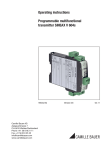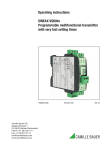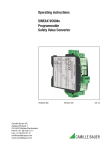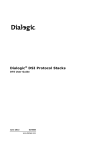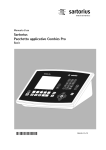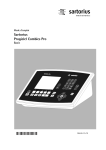Download Operating instructions SINEAX VB 604s Programmable
Transcript
Operating instructions SINEAX VB 604s Programmable multifunctional transmitter with REMOTE I/O functionality. VB604s Be Camille Bauer AG Aargauerstrasse 7 CH-5610 Wohlen/Switzerland Phone +41 56 618 21 11 Fax +41 56 618 35 35 [email protected] www.camillebauer.com Version 01 04.11 Operating instructions SINEAX VB 604s Programmable multifunctional transmitter with REMOTE I/O functionality. First read, then … The unobjectionable and safe operation presupposes that these operating instructions have been read and understood! Devices may only be disposed of in a professional manner! Contents 1. Functional description ................................................... 2 2. Connection to a PC and communication via CB-Manager .................................................................. 3 3. Block diagram ............................................................... 4 4. Technical data ............................................................... 4 5. Modbus interface .......................................................... 6 5.1 EIA-RS-485 Standard ............................................. 6 5.2 Coding and addressing ........................................... 6 5.3 Mapping .................................................................. 7 5.4 Device identification ................................................ 7 5.5 Signal flow............................................................... 8 5.6 Measured values ..................................................... 9 5.7 Configuration parameters ..................................... 10 6. Electric connections ................................................... 16 7. Dimensional drawing .................................................. 18 8. Accessories ................................................................ 18 9. Conformity declaration ............................................... 18 1. Functional description VB604s is a multifunctional transmitter for top-hat rail assembly with the following main characteristics: ● Measurement of DC voltage, DC current, temperature (RTD, TC) and resistance ● Programmable remote I/O functionality. Readout of all input variables and internally calculated values via MODBUS. Simultaneously, the outputs and the relay may be controlled via MODBUS. ● Free selection as to whether the output variables are dependent on the input variables or whether the outputs are controlled independently of the inputs via MODBUS. ● Sensor connection without any external jumpers ● 2 inputs (e.g. for sensor redundancy or difference formation) ● 2 outputs (U and/or I) ● 2 inputs can be linked with each other and allocated to the 2 outputs which enables calculations and sensor monitoring (e.g. prognostic maintenance of sensors) ● System capability: Communication via Modbus interface ● Freely programmable relay, e.g. for limit or alarm signalling ● AC/DC wide-range power supply unit ● Pluggable high-quality screw terminals 2 All settings of the instrument can be adapted to the measuring task by PC software. The software also serves visualising, commissioning and service. A distinctive feature of SINEAX VB604s is constituted by the fact that, apart from the full functional range of a multifunctional signal converter, it can also be used as a small remote I/O system. In SINEAX VB 604s, the signal flow may be controlled in such a way that the input signal or the measured variable is not inevitably routed to the output. However, the values can be communicated via MODBUS. In this operating mode, the outputs as well as the relay may also be controlled via MODBUS. Whether this remote functionality is applicable to both or only to one channel can be freely selected. If only one channel is selected, the second one behaves like a normal signal converter. 2. Connection of SINEAX VB604s to a PC and communication via CB-Manager. To determine which COM port has been allocated to the RS485 converter (if required), please proceed as follows: VB604s communicates with a PC (CB-Manager) via an RS 232/RS485 interface and a MODBUS protocol. Select the following settings in this respect: Select the RS 232/ RS485 interface under Options / Interface. This is also applicable if an RS485/USB converter is used and the converter is connected to the computer via the USB connection. Subsequently, enter the following settings under Options / Interface / Settings: The COM port of an external RS232 or RS485 converter may be determined (and, if required, changed) via the Windows system control. Example for Windows XP: System control => System This example shows the COM ports of a PCMCIA card and a USB-RS232 converter: - Silicom Serial Card: COM1 - USB-RS232 adapter: COM4 The existing COM ports are determined as the communication interface when starting the program and selecting RS232/RS485. Only COM ports found are available for selection. If you use the Camille Bauer USB-RS485 converter (Article Number 163189), the same is to be connected as follows: Limiting the range of possible device addresses speeds up the search of connected devices considerably. Example: If only 2 devices are connected, it makes sense to select the address range from 1 to 2. All settings are stored as the program is terminated. If the COM port is not available upon the next start of the program (e.g. because the converter has not been plugged in) another valid interface is set. 3 3. Block diagram Power supply 3.7kV 3.7kV 2.3kV Input 3.7kV A D D Analogue output A1+ A– A2+ A 0.5kV μP Table 1: Input variables, measuring ranges DC voltage [mV] DC voltage [V] DC current [mA] Resistance [Ω] Measuring range Minimum span –1000 … 1000 mV –300 … 300 V –50 … 50 mA 2 mV >1 V 0,2 mA 0 … 5000 Ω 8Ω RTD Pt100 –200 ... 850 °C 20 K RTD Ni100 –60 ... 250 °C 15 K TC Type B 0 ... 1820 °C 635 K TC Type E –270 ... 1000 °C 34 K TC Type J –210 ... 1200 °C 39 K TC Type K –270 ... 1372 °C 50 K TC Type L –200 ... 900 °C 38 K TC Type N –270 ... 1300 °C 74 K TC Type R –50 ... 1768 °C 259 K TC Type S –50 ... 1768 °C 265 K TC Type T –270 ... 400 °C 50 K TC Type U –200 ... 600 °C 49 K TC TypeW5Re-26Re 0 ... 2315 °C 135 K TC TypeW3Re-25Re 0 ... 2315 °C 161 K Direct voltage For limits see Table 1 Ri > 10 MΩ, continuous, overload max. ±1200 mV Direct current Measuring range mA 4 Resistance measurement types Pt100 (IEC 60 751), adjustable Pt20…Pt1000 Ni100 (DIN 43 760), adjustable Ni50…Ni1000 Measuring range limits See Table 1 Wiring 2, 3 or 4-wire connection Measuring current 0.2 mA Line resistance 30 Ω per line, in 2-wire connection adjustable or calibratable Thermocouples TC Thermocouples Type B, E, J, K, N, R, S, T (IEC 60 584-1) Type L, U (DIN 43 760) Type W5Re-W26Re, W3ReW25Re (ASTM E988-90) Measuring range limits See Table 1 Cold junction compensation Internal (with installed Pt100), with Pt100 on terminals, external with reference junction thermostat –20…70 °C Resistance measurement, teletransmitter, potentiometer Measuring range limits See Table 1 Wiring 2, 3 or 4-wire connection Resistance teletransm. Type WF and WF DIN Measuring input 1 Measuring range mV Bus + – GND Resistance thermometer RTD 4. Technical data Measurement type Contact For limits see Table 1 Ri = 11 Ω, continuous, overload max. ±50 mA Measuring current 0.2 mA Line resistance 30 Ω per line, in 2-wire connection adjustable or calibratable Measuring input 2 Direct current Measuring range mA Same as Measuring input 1 Direct voltage Measuring range mV Transmission behaviour Same as Measuring input 1 Resistance thermometer RTD Measured variables for the outputs Same as Measuring input 1 except: Wiring 2 or 3-wire connection Thermocouples TC Same as Measuring input 1 Resistance measurement, teletransmitter, potentiometer Same as Measuring input 1 except: Wiring 2 or 3-wire connection Please note: The following device types are available: a) VB604s with measuring input for 2x direct current [mA] Measuring inputs 1 and 2 are galvanically connected. If 2 input sensors or input variables are used, observe combination options in Table 3 and circuit instructions p.17! Transmission function Settling time: • • • • • • • Input 1 Input 2 Input 1 + Input 2 Input 1 – Input 2 Input 2 – Input 1 Input 1 · Input 2 Minimum value, maximum value or mean value of Input 1 and Input 2 • Sensor redundancy Input 1 or Input 2 Linear, user-specific via basic value table (24 basic values per measured variable) Adjustable 1…30 s Limit values and monitoring Analog outputs 1 and 2 Limit values 1 and 2 The two outputs are galvanically connected and have a common earth. Voltage and current output software-configurable. Number 2 Measured variables for limit values • Input 1 • Input 2 • Measured variable for outputs • Input 1 – Input 2 (e.g. drift monitoring in case of 2 sensors) • Input 2 – Input 1 (e.g. drift monitoring in case of 2 sensors) Functions Absolute amount Gradient dx/dt (e.g. temperature gradient monitoring) Time delay Adjustable 0…3600 s Signaling Relay contact, alarm LED, Status 1 Direct current Output range Burden voltage Open circuit voltage Limit Residual ripple ± 20 mA, range may be freely set max. 12 V < 20 V Adjustable, max. ±22 mA <1% pp related to 20 mA Direct Voltage Output range Load Current limit Limit Residual ripple ± 10 V, range may be freely set max. 20 mA Approx. 30 mA Adjustable, max. ±11 V <1% pp related to 10 V Output settings Sensor breakage and short circuit monitoring measuring input Limit Gain/offset trimming Inversion Signalling Relay contact output Other monitoring operations Contact Switching capacity 1 pole, normally open contact AC: 2 A / 250 V AC DC: 2 A / 30 V Drift monitoring Bus/programming connection Interface, protocol Baudrate RS-485, Modbus RTU 9,6...115,2 kBaud, adjustable Sensor redundancy Relay contact, alarm LED, Status 1 Output value in case of a fault Monitoring of measured value between 2 input sensors for a certain period of time (e.g. due to different sensor response times). If this time is exceeded, an alarm is signalled. (See Limit values 1 and 2) Measurement with 2 temperature sensors; if Sensor 1 fails (fault) Sensor 2 is activated for bridging (see measuring variable for outputs). Alarm signalling Relay contact Alarm LED Time delay With closed contact, the yellow LED shines, invertible Adjustable 0…60 s 5 Output value in case of a fault For sensor breakage and short circuit, value adjustable –10… 110% Power supply Rated voltage UN Tolerance 24…230 V DC ±15% 100…230 V AC, 45…400 Hz ±15% Topology Both ends of the bus cable must be equipped with a line terminator. Supplementing the line termination resistance RT of the EIA-RS-485 standard an additional resistance RU (pullup) must be wired against the supply voltage and a resistance RD (pulldown) against the reference potential. These two resistances ensure a defined idle potential on the line when none of the participants is sending. Displays at the instrument LEDs in front plate Power ON: Relay contact: Alarm: Green LED, the LED flashes if the device is addressed via the interface. Yellow LED Red LED Configuration, programming Operation with PC software «CB-Manager» 5. Modbus interface 5.1 EIA-RS-485 Standard The EIA-RS-485 standard defines the physical layer of the Modbus interface. Coding The data is transmitted in serial form via the 2-wire bus. The information is coded as a difference signal in the NRZ code. Positive polarity signals a logic 1, negative polarity signals the logic 0. Connections A shielded, twisted, 2-conductor cable should be used as a bus cable. Shielding serves improved electromagnetic compatibility (EMC). Depending on the source of information, the description of Conductor A and B is contradictory. System requirements Cable: Twisted, 2-wire line, wave resistance 100 to 130 Ω, min. 0.22mm2 (24AWG) Line length: Maximum 1’200m depending on the transmission rate Participants: Maximum 32 per segment Rate: 9’600, 14’400, 19’200, 38’400, 56’000, 57’600, 115’200 Baud Mode: 11 bit format - 2 stop bit without parity or 1 stop bit with even/uneven parity 5.2 Coding and addressing Addressing In the telegram, all data addresses refer to zero. The first data element is always addressed via the 0 address. For example, the coil which is known as "Coil 1" in the device, is addressed as "Coil 0" in the telegram. Coil 127 is addressed as 0x007E. The potential difference of all bus participants may not exceed ± 7V. Therefore, the use of a shield or a third conductor (ref line) is recommended to create potential equalisation. Holding register 40001 is addressed as Register 0 in the telegram. The function code of the telegram already states that a "holding register" is concerned. Consequently, the reference to "4XXXX“ is implicit. Holding register 40108 is addressed as 0x006B (107 decimal). U A R T R S + 4 – 8 5 6 Serialisation The specification defines the telegrams as byte sequences. The respective physical layer (RS485, Ethernet) is responsible for the correct serialisation of the bytes (MSB or LSB First). RS485 (UART, COM) transmits the "Least Significant Bit“ first (LSB First) and adds the synchronisation and backup bits (start bit, parity bit and stop bit). 5.3 Mapping Address space The address space may be divided into 4 address spaces according to the 4 types of data. Space r/w Address area Function code 00001 - 09999 0x01 0x05 0x0F Read Coil Status 1) Force Single Coil 1) Force Multiple Coils 1) in- Only reada10001 - 19999 ble 0x02 Read Input Status 1) Only reada30001 - 39999 ble 0x04 Read Input Register 1) 0x03 0x06 0x10 Read Holding Registers Force Single Register 1) Preset Multiple Registers Readable Writeable Coil Discrete put Bits Bits are represented within a byte in a conventional manner with the MSB (Bit 7) leftmost and the LSB (Bit 0) rightmost (0101’1010 = 0x5A = 90). An example for the inquiry of Coils 20 to 40 of Slaves 17. Response Input register Holding register Readable Writeable 40001 - 49999 Byte Inquiry 0 Slave address 0x11 Slave address 0x11 1 Function code 0x01 Function code 0x01 1) 2 Start address 0x00 Byte count 0x03 3 19 = Coil 20 0x13 Byte 0 0xCD To reduce the commands, the device image was represented as far as possible in "holding registers". 4 Number 0x00 Byte 1 0x6B 5 20…40 = 21 0x15 Byte 2 0x01 not implemented Segments The start address in the inquiry plus the bit position in response byte 0 corresponds to the coil address. Commenced bytes are completed with zeros. Coil 27...20 = 0xCD = 11001101b → Coil20 = ON, Coil21 = OFF, Coil22 = ON, etc. Bytes Modbus does not know a byte or character data type (see address space). Strings or byte arrays are mapped in "holding registers“ (2 characters per register) and transmitted as a "character stream", e.g. "Hello_World“. Address Description Permitted function codes 40209 - 40210 40257 - 40284 40515 - 40516 40517 - 40761 Actions Measured values, status Settings (Modbus) Configuration data 0x03 0x10 Read Holding Registers Preset Multiple Registers 41076 Device type 0x03 Read Holding Registers Syntax Address Start address of the described data block (register, coil or input status) Register HEX char Register HEX char Description Unique variable or structure description 40101 Ox4865 ‚H’ ‚e’ 40104 0x576F ‚W’ ‚o’ Data type 40102 Ox6C6C ‚l’ ‚l’ 40105 0x726C ‚r’ Data type of variable (U: unsigned, INT: integer, 8/16/32 bit, REAL or CHAR[..]) 40103 Ox6F5F ‚o’ ‚_’ 40106 0x6400 ‚d’ # Offset from the start address in the data type unit, for Byte 0: Low, 1: High byte Default Value upon derlivery or after a hardware reset Description Exact details concerning the variable described ‚l’ Words Registers or words are transmitted according to specification in "Big Endian“ format, e.g. Read Holding Register 40101 of Slave 17. Float Modbus does not know any data types to represent floating point numbers. On principle, any data structures may be mapped on the 16Bit register ("cast“). The IEEE 754 standard is the most used standard to represent floating point numbers. Bit 31 24 23 16 15 8 7 0 5.4 Device identification The device is identified by "Read Slave ID“. Function 11h: Report Slave ID Master telegram: Device address Function CRC ADDR 0x11 LO HI V E E E E E E E E M M M M M M M M M M M M M M M M M M M M M M M Exponent Mantissa Slave telegram: Algebraic sign The first register contains Bits 15 – 0 of the 32-bit number (bit 0…15 of the mantissa). Device Address ADDR Function Number data bytes 0x11 3 Slave ID Sub ID Data 2 CRC LO HI The second register contains Bits 16 – 32 of the 32-bit number (algebraic sign, exponent and Bit 16- 22 of the mantissa). 7 Device information Device ID Sub-ID Device Description 0x01 0x00 VR660 Temperature controller 0x02 0x00 A200R Display 0x03 0x01 CAM Universal measuring unit for heavy current variables 0x04 0x00 APLUS Multifunctional display 0x05 0x00 V604s Universal transmitter 0x05 0x01 VB604s Universal transmitter multi in/out Adress Description Data type Description 41076 DEVICE UINT16 Device type Bit 0 1 2 3-15 Description Reserved Reserved 0: V / mA inputs 1: 2 x mA inputs Reserved 5.5 Signal flow The following diagram shows the VB604s signal flow. All relevant measured variables and parameters determining the signal flow are represented. Input 1 Input 2 Sensor table TSET Legend Settling time Measured variables Configuration, paramerters INPUT2 INPUT1 SCALE1 SCALE2 Output link MATRIX Transm. behaviour - x^2 Limit value link - TAB1, TAB2 MEAS1 MEAS2 Measured variable 1 Measured variable 2 LIMIT2 Measured variable limit value 2 LIMIT1 Measured variable limit value 1 - inv OUTSET1, Bit 2 LIMITA OUTSET2, Bit 2 LIMIT2ON LIMIT2OFF LIMIT1OFF LIMIT1ON TONLIMITA TOFFLIMITA Limit value delay Limit value 1 STATUS1 Limit value 2 PERCENT2 PERCENT1 Output 1 [%] Output behaviour Output 2 [%] Limit OUTSET1 STATUS1 Breakageh Short circuit ALARMSETA (without inversion) Alarm link OUTSET2 Alarm delay Rise, drop TON TOFF Value in case of a fault ERRVAL1 OUTSET1, Bit 6,7 STATUS1, Bit 4-5, 7-8 Alarm1 STATUS1 Alarm2 ALARMSETA, Bit 7 ERRVAL2 RELAISSIM OUTSET2, Bit 6,7 STATUS1, Bit 4-5, 7-8 ALARMSETA, Bit 0-7 Relay 1 status Trimming TRIM1 OUTPUT1 Output 1 [mA / V] 8 TRIM2 OUTPUT2 Output 2 [mA / V] LED2 Relay 1 LED3 inv 5.6 Measured values Triggering action Address Description Data type 40209 ACTION UINT16 40210 # Default Description 0 This register starts actions. ACTDAT Action Description 18 Input 1: With short-circuited input terminals, the line calibration is realised and the measured parameters are stored in the device. This procedure is indicated by a flashing green LED. 19 Line calibration at Input 2 (same as Input 1) Additional information for the implementation of an action. Simulation of output variables • Writing into the PERCENT1, PERCENT2, OUTPUT1, OUTPUT2 registers interrupts the signal flow to the respective variable and the desired value is specified (However, percent and output value cannot be simulated simultaneously). The status of the simulation mode can be read in the STATUS2 status register. • The simulation mode is terminated by writing 0 into the respective bits in the STATUS2 register. • VB604s: - After a change of the configuration parameters, the desired value must be specified again. - A relay parameter can be specified by writing into the RELAISSIM register (only if ALARMSET for relay = 00h). Current measured variables Address Description Data type 40257 STATUS1 UINT16 # Default 0 Description Status 1 Bit 0 1 2 3 4 5 6 7 8 9 10 11 12 13 14 15 40258 STATUS2 UINT16 0 Description Reserved Reserved Device fault Parameter fault Sensor breakage Sensor short circuit Reserved Sensor breakage Sensor short circuit Reserved Alarm 1 Alarm 2 (relay 1 status before inverting) Limit value 1 Limit value 2 Relay 1 status Device reset or new parameter values Input 1 Input 1 Input 2 Input 2 Status of the simulation mode: A set bit indicates the simulation mode of the respective register. Bit 0 1 2 3 Description Output 1 (PERCENT1) Output 1 (OUTPUT1) Output 2 (PERCENT2) Output 2 (OUTPUT2) The simulation mode is terminated by writing zeros into the respective bit positions (0..3). 40259 INPUT1 REAL 0.0 Measured value Input 1 40261 INPUT2 REAL 0.0 Measured value Input 2 40263 MEAS1 REAL 0.0 Measured variable for Output 1 40265 MEAS2 REAL 0.0 Measured variable for Output 2 40267 LIMIT1 REAL 0.0 Measured variable for Limit value 1 40269 LIMIT2 REAL 0.0 Measured variable for Limit value 2 40271 T_JUNCTION1 REAL 0.0 Cold junction temperature Input 1 40273 T_JUNCTION2 REAL 0.0 Cold junction temperature Input 2 40275 ELAPSED UINT32 0 Operation hour counter [s ] 40277 PERCENT1 REAL 0.0 Output 1: Scaled output variable in % 9 40279 PERCENT2 REAL 0.0 Output 2: Scaled output variable in % 40281 OUTPUT1 REAL 0.0 Output 1 [mA] / [V] 40283 OUTPUT2 REAL 0.0 Output 2 [mA] / [V] 40290 RELAISSIM UINT16 0 Specify relay status Bit Description 0 0: Relay 1 deactivated, 1: Relay activated - Relay specification only possible if ALARMSET for relay = 00h 5.7 Configuration parameters Settings Address 40515 40516 Description DEVADDR MODBUS Data type UINT16 UINT16 # Default 01h 3222h Description MODBUS Slave address (1…247) MODBUS settings Bit Description 0-2 Baudrate 0: 9600 1: 14400 2: 19200 3: 38400 4: 56000 5: 57600 6: 115200 7: Reserved 0: Odd parity 1: Even parity 0: Parity disabled 1: Parity enabled 0: 1 Stop bit 1: 2 Stop bits Response delay [ms] (5..255) 3 4 5 8-15 Resetting of communication settings Once the MODBUS settings have been stored in the device, communication with the device is only possible if the settings are known. The following technique resets the MODBUS settings to the delivery status: - Device address: 01h - Baudrate: 19200 - Parity: None - Stop bits: 2 A plug prepared for this purpose (Terminal + is connected to Terminal GND with a resistance of 1 kOhm) is connected to the RS485 interface before the device is switched on. After the device has been switched on, the red LED shines for approx. 30 seconds. During this time, the green LED flashes. Subsequently, the red LED turns off (the green LED continues flashing). Within further 30 seconds, this plug has to be removed from the device. After the successful completion of this procedure, the communication default settings are stored again in the device. If the procedure described is not adhered to, the interface parameters are not changed. 10 Configuration Address Description Data type 40517 DATE 40519 40523 # Default Description UINT32 0 Configuration date (UTC time stamp in seconds starting 1.1.1970) TAG CHAR[8] “V604s“\0 Device text or “VB604s“\0 INPUT1 UINT8 0 00h at 2xmA: 40h Type of measurement Input 1 FFh: Measurement is inactive Wiring variant A 00h: Voltage measurement [mV] 04h: Thermocouple internally compensated [K] 60h: Thermocouple with ext. cold junction thermostat [K] 21h: Resistance thermometer 2-wire [K] 22h: Resistance thermometer 3-wire [K] 23h: Resistance thermometer 4-wire [K] 24h: Thermocouple with ext. Pt100 on Terminals 1-4 [K] 44h: Thermocouple with ext. Pt100 on Terminals 2-8 [K] 01h: Resistance measurement 2-wire [Ω] 02h: Resistance measurement 3-wire [Ω] 03h: Resistance measurement 4-wire [Ω] 42h: Resistance teletransmitter WF [Ω] 62h: Resistance teletransmitter WFDIN [Ω] 20h: Voltage measurement [V] 40h: Current measurement [mA] 06h: Sensor earthed: Voltage measurement [mV] 07h: Sensor earthed: TC internally compensated [K] 66h: Sensor earthed: TC, ext. cold junction thermostat [K] 27h: Sensor earthed: TC with ext. Pt100 on Terminals 1-4 [K] Terminal 3,4 3,4 3,4 1,4 1,3,4 1,2,3,4 1,3,4 3,4,2,8 1,4 1,3,4 1,2,3,4 1,3,4 1,3,4 6,4 5,4 3,4 3,4 3,4 1,3,4 Wiring variant B 10h: Voltage measurement [mV] 14h: Thermocouple internally compensated [K] 70h: Thermocouple with ext. cold junction thermostat [K] 31h: Resistance thermometer 2-wire [K] 32h: Resistance thermometer 3-wire [K] 54h: Thermocouple with ext. Pt100 on Terminals 1-4 [K] 34h: Thermocouple with ext. Pt100 on Terminals 2-8 [K] 11h: Resistance measurement 2-wire [Ω] 12h: Resistance measurement 3-wire [Ω] 52h: Resistance teletransmitter WF [Ω] 72h: Resistance teletransmitter WFDIN [Ω] 16h: Sensor earthed: Voltage measurement [mV] 17h: Sensor earthed: TC internally compensated [K] 76h: Sensor earthed: TC, ext. cold junction thermostat [K] 50h: 2nd current input [mA] 7,8 7,8 7,8 2,8 2,7,8 7,8,1,4 2,7,8 2,8 2,7,8 2,7,8 2,7,8 7,8 7,8 7,8 6,4 Combination limits are separately shown in a table on page 14. 1 FF Sensor type Input 1 FFh: Linear 0: 1: 2: 3: 4: 5: 6: 7: 8: 9: 10: 11: 12: 13: 14: RTD Ptxxx (e.g. Pt100) RTD Nixxx Customer-specific characteristic curve (only with NLB) TC Type B TC Type E TC Type J TC Type K TC Type L TC Type N TC Type R TC Type S TC Type T TC Type U TC Type W5-W26Re TC Type W3-W25Re Automatic parameter correction2 11 Address Description Data type # 40524 INPRANGE1 REAL Measuring range Input 1 Default Description Variable Range Minimum span U[mV]: U[V]: RTD: TC: R: ±0 mV … 1000 mV ±0 V … 300 V Acc. sensor limits Acc. sensor limits 0 … 5000 [Ω] see special case WF, WFDIN * ±0 … 50 mA 2 mV 1V I [mA]: 8 Ohm 0.2 mA 2 Automatic parameter correction 0 0.0 at 2xmA: 4.0 Measuring range start 1 1000.0 at 2xmA: 20.0 Measuring range end 40528 SCALE1 REAL 1.0 Scaling factor for INPUT1 (larger than 0.0) 40530 SENSVAL1 REAL 100.0 Input 1: Sensor value [Ω] at 0°C (e.g. 100.0 for Pt100) Pt20 … Pt1000 Ni50 … Ni1000 WF, WFDIN: SENSVAL1=Rd Automatic parameter correction2 40532 REF1 REAL 0.0 Reference value Input 1: – Line resistance [Ω] in 2-wire measurement: 0…30 Ohm – Reference temperature in TC ext. comp.: -20 … 70 °C Automatic parameter correction2 40534 INPUT2 UINT8 0 FFh at 2xmA: 50h Type of measurement Input 2 (same as Input 1) 1 FFh Sensor type Input 2 (same as Input 1) 40535 INPRANGE2 REAL Measuring range Input 2 (same as Input 1) 0 0.0 at 2xmA: 4.0 Measuring range start 1 1000.0 at 2xmA: 20.0 Measuring range end 40539 SCALE2 REAL 1.0 Scaling factor for INPUT2 (larger than 0.0) 40541 SENSVAL2 REAL 100.0 Input 2: Sensor value [Ω] at 0°C (e.g. 100.0 for Pt100) Pt20 … Pt1000 Ni50 … Ni1000 WF, WFDIN: SENSVAL1=Rd Automatic parameter correction2 40543 REF2 REAL 0.0 Reference value Input 2: – Line resistance [Ω] in 2-wire measurement: 0 … 30 Ohm – Reference temperature [°C] in TC ext. comp.: -20 … 70 °C 40545 FREQ REAL 50.0 System frequency [Hz]: 10 … 100 Hz Automatic parameter correction2 * Resistance teletransmitter For teletransmitters the measuring range is defined by 3 resistance values Input 2: Same as Input 1. 1 Meaning Ra Ra Rd INPRANGE1, measuring range end Re Re SENSVAL1 Rd Parameter INPRANGE1, measuring range start 0% 1 2 3 7 4 8 Ra 100% 3 7 Rd Re 4 12 2 8 0% 100% Address Description Data type Default Description 40547 TSET REAL 1.0 Settling time (99%) [s] (1 … 30) Automatic parameter correction2 40549 SETTING UINT16 00h 40550 MATRIX UINT8 # Settings Bit Description 0 1 2 3 4 Recognition of the type of connection (2L, 3L, 4L) after reset Input 1: Breakage monitoring activated Input 2: Breakage monitoring activated Input 1: Short circuit monitoring activated Input 2: Short circuit monitoring activated Linking of inputs with outputs 0 01h Output 1: 00h: 01h: 02h: 03h: 04h: 05h: 06h: 07h: 08h: 09h: 81h: 82h: 87h: 88h: 89h: Not used Input 1 Input 2 Input 1 + 2 Input 1 – 2 Input 2 – 1 Input 1 * 2 Minimum value (Input 1,2) Maximum value (Input 1,2) Mean value (Input 1,2) Sensor redundancy: Input 1 normally Sensor redundancy: Input 2 normally Sensor redundancy: Minimum value (Input 1,2) Sensor redundancy: Maximum value (Input 1,2) Sensor redundancy: Mean value (Input 1,2) - Only measured variables of the same unit may be linked. - Product formation: Only possible for combinations V*mV, V*mA, mA*mA, mV*mA and mV*mV. Sensor redundancy - Measured variable in case of a fault: INPUTx which does not show a fault - Limitations: - The same measuring range for both inputs - The same scaling factors (always 1.0) - No output value in case of a fault - Temperature measurement - Breakage or short circuit monitoring active 1 40551 LIMITA UINT8 00h at 2xmA: 02h Output 2 (same as Output 1) Setting of limit values 0 0 Measured variable for Limit value 1 Bit Description 0-4 Limit value 6 7 0: Not used 1: Input 1 (INPUT1) 2: Input 2 (INPUT2) 3: Measured variable Output 1 (MEAS1) 4: Measured variable Output 2 (MEAS2) 5: Input 1 – Input 2 6: Input 2 – Input 1 Absolute value of measured variable for the limit value 1: Gradient dx/dt Note: Drift monitoring is realised by difference calculation. Only measured variables of the same unit may be linked. 1 0 Measure variable for Limit value 2 (same as Limit value 1) 13 Address Description Data type 40552 ALARMSETA UINT8 # Default Description Relay and alarm (Relay 1) 0 00h Relay, LED3 Bit Description 0 1 2 3 7 Limit value 1 Limit value 2 Sensor breakage Input 1 or 2 Sensor short circuit Input 1 or 2 Inverted These settings may all be combined with each other. 1 00h Alarm1, LED2 Bit Description 0 1 2 3 Limit value 1 Limit value 2 Sensor breakage Input 1 or 2 Sensor short circuit Input 1 or 2 These settings may all be combined with each other. 40553 TON REAL 0.0 Alarms rise delay [s]: 0..60 40555 TOFF REAL 0.0 Alarms drop delay [s]: 0..60 40557 TONLIMITA REAL 0.0 Limit values 1,2: rise delay [s]: 0..3600 40559 TOFFLIMITA REAL 0.0 Limit values 1,2: drop delay [s]: 0..3600 40561 LIMIT10N REAL 0.0 Switching-on threshold Limit value 1, unit of LIMIT1 40563 LIMIT10FF REAL 0.0 Switching-off threshold Limit value 1, unit of LIMIT1 40565 LIMIT2ON REAL 0.0 Switching-on threshold Limit value 2, unit of LIMIT2 40567 LIMIT2OFF REAL 0.0 Switching-off threshold Limit value 2, unit of LIMIT2 40569 OUTSET1 UINT16 05h at VB604s 01h Output settings Output 1 Bit Description 0-1 Output limit 0: ±0 mA or 0 V 1: ±1 mA or 0.5 V 2: ±2 mA or 1 V 3: –0.2/+0.5 mA or –0.1/+0.25 V (e.g. 3.8 mA … 20.5 mA) Signal flow 0: Interrupted (only possible with VB604s) 1: Activated (V604s) Output configuration 0: Current output 1: Voltage output Inverting 0: normal, 1: inverted Table 0: without, 1: with table Output in case of a fault 0: PERCENTx, 1: ERRVALx in case of fault Input 1 2: ERRVALx in case of fault Input 2 3: ERRVALx in case of fault Input 1 or 2 Transmission function 0: User-defined 1: Linear 2: Quadratic 3: Volume of a horizontal cylinder 2 3 4 5 6-7 8-15 40570 40574 40578 14 OUTRANGE1 TRIM1 ERRVAL1 REAL REAL REAL Output range Output 1 Automatic parameter correction2 0 4.0 Minimum value 1 20.0 Maximum value –20…20 [mA] / –10…10 [V] –20…20 [mA] / –10…10 [V] Output trimming Output 1 Automatic parameter correction2 0 0.0 Offset trimming [in % of the output range, setting range +/– 10%]1 1 100.0 Gain trimming [in % of the output range, setting range 90…110%]1 0.0 Output value Output 1 in case of a fault [in % of the output range, setting range -10…+110%)1 Address Description Data type 40580 OUTSET2 UINT16 40581 OUTRANGE2 REAL 40585 TRIM2 REAL # Default Description 05h, Output settings Output 2 (same as Output 1) at VB604s 01h Output range Output 2 0 4.0 Minimum value –20…20 [mA] / –10…10 [V] 1 20.0 Maximum value –20…20 [mA] / –10…10 [V] Output trimming Output 2 0 0.0 Offset trimming [in % of the output range, setting range +/– 10%]1 1 100.0 Gain trimming [in % of the output range, setting range 90…110%]1 40589 ERRVAL2 REAL 0.0 Output value Output 2 in case of a fault [in % of the output range, setting range -10…+110%)1 40591 GRAD_TIME REAL 1.0 Time span between two measured values for gradient calculation of limit values in seconds Range: 4 x TSET … 26210 s Automatic parameter correction2 40593 NUMTAB UINT8 REAL Number of table values 0 0 Number of table values Table 1 Automatic parameter correction2 1 0 Number of table values Table 2 Automatic parameter correction2 -10.0 Table 1: Y-value (-10%) in % of the measuring range Table 1: X-values in % of the measuring range 40594 TAB1_YA 40596 TAB1_X REAL[20] 0.0 40636 TAB1_Y REAL[20] 0.0 Table 1: Y-values in % of the measuring range 40676 TAB1_YE REAL 110.0 Table 1: Y-value (110%) in % of the measuring range 40678 TAB2_YA REAL -10.0 Tabelle 1: Y-Wert (-10%) in % vom Messbereich 40680 TAB2_X REAL[20] 0.0 Tabelle 1: X-Werte in % vom Messbereich 40720 TAB2_Y REAL[20] 0.0 Tabelle 1: Y-Werte in % vom Messbereich 40760 TAB2_YE REAL 110.0 Tabelle 1: Y-Wert (110%) in % vom Messbereich 1 Max. +/-22 mA or +/-11 V 2 Automatic correction of parameters in the device. Each parameter must range within permitted limits. These partly depend on other parameters. If parameters determining the limits of dependent parameters are changed, (e.g. measuring range is dependent on the type of measurement), the respective parameters are automatically limited to the permitted parameters. The status will show that such a correction has taken place. Limitations of configuration parameters Due to linking and scaling, the measuring ranges are rescaled to different ranges. Options to combine types of measurement This is automatically realised in the device. Register: 40523, 40534 Abbreviations: The numerous types of measurement can be combined with each other in different ways. k1: SCALE1 k2: SCALE2 See Table 3 p.18 T1a…T1e INPRANGE1 Min1 = T1a * k1 Max1 = T1e * k1 The "earthed" combination is used if both sensors are connected to each other. T2a…T2e INPRANGE2 Min2 = T2a * k2 Max2 = T2e * k2 Matrix Minimum value MEAS1 Maximum value MEAS1 Input 1 Min1 Max1 Input 2 Min2 Max2 Input 1 + 2 Min1 + Min2 Max1 + Max2 Input 1 - 2 Min1 – Max2 Max1 – Min2 Input 2 - 1 Min2 – Max1 Max2 – Min1 Measuring ranges Register: 40524, 40535 see table 1 / page 3 15 Matrix Minimum value MEAS1 Maximum value MEAS1 Linearisation tables Input 1 * 2 Input 1 Min1 Max1 ≥0 >0 <0 ≤0 <0 >0 ≥0 >0 <0 ≤0 >0 >0 ≥0 >0 <0 ≤0 <0 >0 Input 2 Min2 Max2 ≥0 >0 ≥0 >0 ≥0 >0 <0 ≤0 <0 ≤0 <0 ≤0 <0 >0 <0 >0 <0 >0 Min1 * Min2 Min1 * Max2 Min1 * Max2 Min2 * Max1 Max1 * Max2 Max1 * Min2 Max1 * Min2 Min1 * Max2 Min (Min1 * Max2, Min2 * Max1) Max1 * Max2 Max1 * Min2 Max1 * Max2 Min1 * Max2 Min1 * Min2 Min1 * Min2 Max1 * Max2 Min1 * Min2 Max (Min1 * Min2, Max1 * Max2) Minimum value (Input 1, 2) Min (Min1, Min2) Min (Max1, Max2) Maximum value (Input 1, 2) Max (Min1, Min2) Max (Max1, Max2) Mean value (Input 1, 2) (Min1 + Min2)/2 (Max1 + Max2)/2 Sensor backup Input 1 Min1 1 Max1 1 Sensor backup Input 2 Min2 1 Max2 1 Sensor backup minimum value Min1 1 (Input 1, 2) Max2 1 Sensor backup maximum value Min1 1 (Input 1, 2) Max2 1 Min1 1 Max2 1 Sensor backup mean value (Input 1, 2) 1 YE Y1..Y5 YA 0% –10% X1..X5 100% –110% The transmission functions stored in registers OUTSET1 or OUTSET2 constitute information for the PC software to generate the desired transmission function with the table values. This information is irrelevant for the device. Characteristic curves: – User-defined, linear, quadratic – Volume of a horizontal cylinder: k1= k2 , T1a = T2a, T1e = T2e 6. Electric connections Setting time Register: 40547 The minimum setting time depends on whether both inputs are configured, on the types of measurement, on breakage and short circuit monitoring. The following minimum setting times result for the input: Type of measurement Minimum setting time [ms] Breakage monitoring Short circuit monitoring Voltage [mV] 315 X – Voltage [V] 160 – – Current [mA] 160 – – Resistance [Ω] 2L 280 X X Resistance [Ω] 3L, WF, WF_DIN 595 X X Resistance [Ω] 4L 435 X X Thermocouple int. comp. 475 X – 16 Circuit Terminals Remarks Measuring input 1 to 8 See Table 1, page 3 Output 1 Output 2 11 (+), 12 (–) 10 (+), 12 (–) Relay contact 9, 13 Power supply 15 (+/~) 16 (–/~) Bus-/programming connection +, –, GND Front plug Wiring with 2 input sensors If 2 input sensors or input variables are used, these must be free of potential or galvanically isolated against each other, on principle! Otherwise, the transmitter may be damaged. Exceptions: • In case of a permitted input combination1 with common (and approved) connections on Terminal 4. E.g. direct voltage mV (Terminal 3, 4) & direct voltage V (Terminal 6, 4) • In case of a permitted input combination1 with the same reference potential (e.g. earth) on Terminal 4 and 8 E.g. 2 thermocouples (on Terminals 3, 4 or 7, 8) with earthed sensor tips or two mV inputs with a common earth potential on Terminals 4 and 8. In these cases, the specified types of measurement must be configured for earthed sensors. 1 See Table 3 "Options to combine types of measurement" page 18 Table 2: Connections of inputs Types of measurement Wiring Input 1 + Direct voltage mV Input 2 3 Wiring Types of measurement If 2 input sensors or input variables are used, observe combination options in Table 3! Input 1 1 8 4 + 3 7 - 4 8 1 2 4 8 1 2 3 4 7 8 Pt100 Thermocouple with Pt100 at the terminals at the other input Resitance thermometer or resistance measurement 2-wire RTD, R Resistance thermometer or resistance measurement 3-wire RTD, R Resistance thermometer or resistance measurement 4-wire 1 2 RTD, R 4 Resistance teletransmitter WF + 3 7 - 4 8 1 Thermocouple with Pt100 at the terminals at the same input 2 Pt100 + 3 7 - 4 8 1 2 3 7 4 8 1 2 3 7 4 8 Ra 8 0% 100% Re or internally compensated 3 4 7 Rd Thermocouple with external cold junction thermostat 2 U [mV] - Input 2 Resistance Teletransmitter WFDIN Direct voltage mA (Input 2 only in corresponding device type) Ra Rd 0% 100% Re + 5 6 4 4 I [mA] - 17 Input 1 Terminals measuring method U [mV] 3,4 7,8 √ √ I [mA] 5,4 √ √ TC ext. 3,4 √ √ √ √ earthed √ √ √ √ √ √ √ √ √ √ √ √ √ √ √ √ √ √ √ √ √ √ √ √ √ √ √ √ √ √ √ √ √ √ √ √ √ √ √ √ 1,3,4 √ √ √ √ √ √ √ R 2L 1,4 √ √ √ √ √ √ √ R 3L 1,3,4 √ √ √ √ √ √ √ R 4L 1,2,3,4 √ √ RTD 2L 1,4 √ √ √ √ √ √ √ RTD 3L 1,3,4 √ √ √ √ √ √ √ WF 1,3,4 √ √ √ √ √ √ √ WF_DIN 1,3,4 √ √ √ √ √ √ √ RTD 4L 1,2,3,4 √ √ √ 9. Conformity declaration EG - KONFORMITÄTSERKLÄRUNG EC DECLARATION OF CONFORMITY Dokument-Nr./ Document.No.: VB604s_CE-konf.DOC Hersteller/ Manufacturer: Camille Bauer AG Switzerland Anschrift / Address: Aargauerstrasse 7 CH-5610 Wohlen Produktbezeichnung/ Product name: Programmierebarer multifunktionaler Messumformer Programmable multifunctional transmitter Typ / Type: Sineax VB604s Das bezeichnete Produkt stimmt mit den Vorschriften folgender Europäischer Richtlinien überein, nachgewiesen durch die Einhaltung folgender Normen: The above mentioned product has been manufactured according to the regulations of the following European directives proven through compliance with the following standards: Nr. / No. R i c h t l i n i e / D i r e c t i ve 2004/108/EG 2004/108/EC Elektromagnetische Verträglichkeit - EMV-Richtlinie Electromagnetic compatibility - EMC directive EMV / EMC Fachgrundnorm / Generic Standard Störaussendung / Emission Störfestigkeit / Immunity EN 61000-6-4 : 2007 EN 55011 : 2007+A2:2007 EN 61000-6-2 : 2005 IEC IEC IEC IEC IEC IEC Nr. / No. R i c h t l i n i e / D i r e c t i ve 2006/95/EG E l e k t r i s c h e B e t r i e b s m i t t e l z u r V e r we n d u n g i n n e r h a l b b e s t i m m t e r S p a n n u n g s grenzen – Niederspannungsrichtlinie – CE-Kennzeichnung : 95 E l e c t r i c a l e q u i p m e n t f o r u s e wi t h i n c e r t a i n v o l t a g e l i m i t s – L o w V o l t a g e D i r e c tive – Attachment of CE marking : 95 2006/95/EC 2 Selectable only in device type 2x direct current [mA] 7. Dimensional drawing 108 111 108 7 8. Accessories USB-RS485 converter (for SINEAX VB604s programming): Article No. 163 189 M e s s ve r f a h r e n / Measurement methods 61000-4-2: 1995+A1:1998+A2:2001 61000-4-3: 2006+A1:2007 61000-4-4: 2004 61000-4-5: 2005 61000-4-6: 2008 61000-4-11: 2004 EN/Norm/Standard IEC/Norm/Standard EN 61010-1: 2001 IEC 61010-1: 2001 Ort, Datum / Place, date: 1 Selectable only in device type 1x direct current [mA] and 1x high voltage [V] 18 √ √ √ 22,5 I [mA] 2 RTD 3L RTD 2L R 3L R 2L earthed TC int. √ √ √ 2,7,8 2,8 2,7,8 2,8 2,7,8 6,4 √ √ 3,4 7,8 √ √ earthed earthed TC ext. 7,8 √ 6,4 TC int. I [mA] 1 U [V] 1 6,4 5,4 √ earthed U [V] 1 earthed Input 2 measuring method U [mV] Table 3: Measuring method combination options Wohlen, 01.April 2011 Unterschrift / signature: M. Ulrich J. Brem Leiter Technik / Head of engineering Qualitätsmanager / Quality manager


















